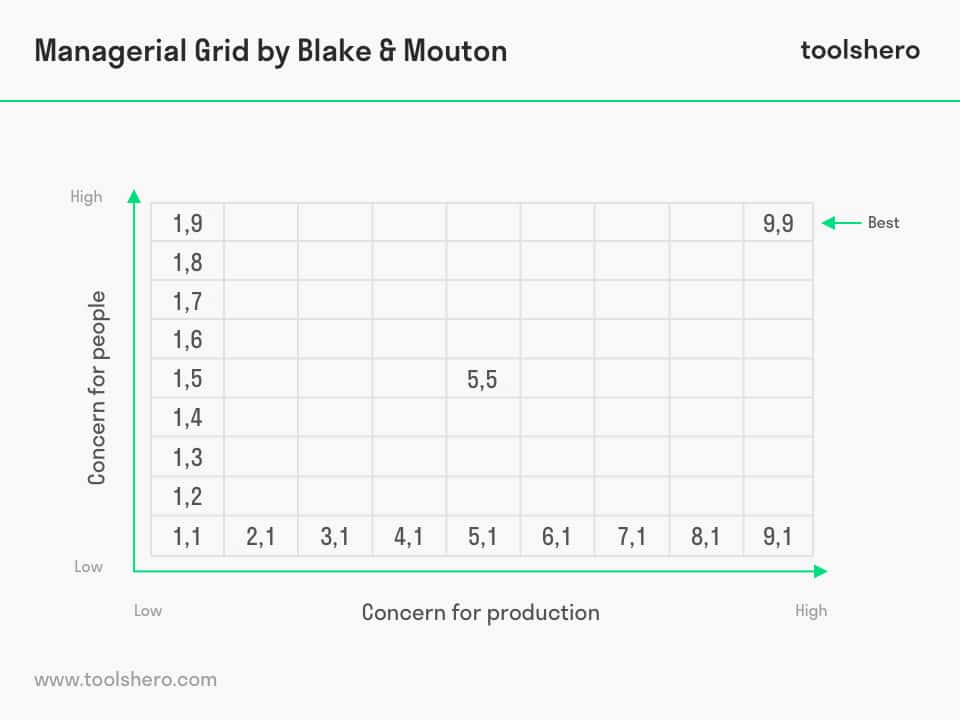Managerial Grid by Blake and Mouton

Managerial Grid: this article explains the Blake and Mouton Managerial Grid in a practical way. After reading you will understand the basics of this powerful management and leadership tool.
Leadership grid
Anticipating on situational leadership, American Robert Blake and Jane Mouton arrived at the conclusion in 1964 that the behaviour of a leader stems from two criteria: people orientation (concern for people) and task orientation (concern for production).
In the so-called managerial grid, they combined these two criteria as a result of which a grid with 81 leadership styles was created.
Managerial Grid : under the microscope
On the vertical axis of the Blake and Mouton Managerial Grid, the concern for people is depicted from low to high. On the horizontal axis, concern for production is represented from low to high.
The more a leader aims at result orientation, the more attention he pays to working methods, work preparation, rules and regulations and the results of the employees. The more emphasis a leader puts on his employees, the more he aims at motivation, guidance and instruction of employees. He will stimulate group connection and fully aim at motivational labour conditions and learning processes of his employees.
Blake and Mouton Managerial Grid
In the Blake and Mouton Managerial Grid score the criteria ‘concern for people‘ and ‘concern for production‘ from 1 (low) to 9 (high). The Blake and Mouton Managerial Grid creates 81 combinations that result in 81 different leadership styles. All these styles are subdivided into four quadrants and five basic leadership styles that are given a name and marks:
1.1 Impoverished Management
In this leadership style the leader shows little or no concern for production and little or no concern for the employee. When the leader does not wish to engage with his employees and lets them muddle on, this is a bad leadership style. Robert Blake and Jane Mouton indicate however that this style can be a conscious choice.
By giving employees the freedom to solve a specific problem, this will affect the production for a short while. But eventually, this will lead to independence and an improved production. When this leadership style is used overly much or continuously, Robert Blake and Jane Mouton recommend to take on a different leadership style.
1.9 Country club
Many new leaders orient themselves towards this style with a high concern for people but a low concern for production. In this style of leadership, leaders just want to be ‘liked‘ by their employees and they do not want to come across as too authoritarian.
The leader wants to understand his employees continuously and wishes to maintain a good relationship with them whatever the cost with the risk that the employees might cut corners and do not pursue the objectives enough. This leadership style may also be the leader’s conscious choice.
The moment an employee has to deal with personal problems the manager’s care and support will be experienced as positive. It will temporarily affect the production but the backlog will be caught up at a later time.
9.1 Task Management
The leader is completely focused on task-orientation. As the production is the leader’s focal point of attention, he forgets and neglects the well being of the employees. This leader is authoritative and he exerts disciplinary pressure.
The leader requires the utmost of the employees and imposes sanctions when they fail to meet the requirements. Robert Blake and Jane Mouton indicate that there are situations in which this style of leadership is necessary. For instance when unpopular measures are taken like cutbacks or reorganization. The leader should not be afraid to show his human side from time to time, however.
5.5 Middle of the road
In this leadership style the ‘happy medium‘ course is adopted. The leader maintains a balance between the needs of the people and the production and the leader scores an average mark on both criteria. According to Robert Blake and Jane Mouton this is not always an ideal leadership style but because of pressure of time such as meeting deadlines, it is a good way to encourage the employees.
9.9 Team Management
The leader that is oriented towards this style should not change this. His employees form a close-knit team and work together on the execution of objectives. The leader has got a lot respect for his employees and enthuses and motivates them.
This is why they are able to bring out the best in themselves, Mutual involvement among the employees is high and they are very loyal to their employer. Such an optimal cooperation is often linked to short-term projects that are carried out by (highly) experienced employees. By paying a lot of attention to the needs of the employees and the production this leader works very efficiently.
The green zone
As the style of the leader is also determined by the situation, Robert Blake and Jane Mouton indicated that the best starting position within the Blake and Mouton Managerial Grid can be found between 5.5 (middle of the road) and 9.9 (team).
They called the space in between the ‘green zone‘. The leadership style is only effective when other styles are applied per situation. They recommend that the basic leadership style must be taken from the green zone. It is advisable to eliminate all emotions towards the employees and to fully focus on the production.
But when emotions are running high among employees, a leader would do well to focus his attention on the people’s needs, even if this is at the expense of the production. It is therefore more efficient to apply various leadership styles.
It’s Your Turn
What do you think? Do you recognize the practical explanation on the Blake and Mouton Managerial Grid or do you have more suggestions/ additions? What are your success factors for working with the Blake and Mouton Managerial Grid?
Share your experience and knowledge in the comments box below.
More information
- Blake, R. R. & Mouton, J. S. (1984). The new managerial grid III. Houston: Gulf Publishing Company.
- Egner, T. (2009). Behavioral Leadership – The Managerial Grid. GRIN Verlag.
How to cite this article:
Mulder, P. (2012). Managerial Grid by Blake and Mouton. Retrieved [insert date] from ToolsHero: https://www.toolshero.com/leadership/managerial-grid-blake-mouton/
Add a link to this page on your website:
<a href=”https://www.toolshero.com/leadership/managerial-grid-blake-mouton/”>ToolsHero.com: Managerial Grid by Blake and Mouton</a>
Published on: 02/12/2012 | Last update: 16/02/2022














3 responses to “Managerial Grid by Blake and Mouton”
May I please have permission to use part or all of you article, “Managerial Grid by Blake and Mouton?” I am writing/ researching a management training guide for a continuing education class here at South Plains College, Lubbock, TX. I’d be honored to cite your article with the corresponding URL link. I’ll await your reply before proceeding with this project. Thanks in advance! Sincerely, Jim Wilhelm
South Plains College. Lubbock, TX
Thank you for your comment, Jim. You can use a part of our article offline if you cite this article with the corresponding URL link. Good luck!
Hi. I’d like to ask about the psychometric properties of the Managerial Grid. Is there any establish reliability and validity for the said tool? Thank youu in advance.